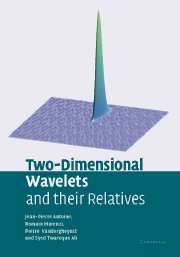Book contents
- Frontmatter
- Contents
- Prologue
- 1 Warm-up: the 1-D continuous wavelet transform
- 2 The 2-D continuous wavelet transform
- 3 Some 2-D wavelets and their performance
- 4 Applications of the 2-D CWT. I: image processing
- 5 Applications of the 2-D CWT. II: physical applications
- 6 Matrix geometry of wavelet analysis. I
- 7 Matrix geometry of wavelet analysis. II
- 8 Minimal uncertainty and Wigner transforms
- 9 Higher-dimensional wavelets
- 10 Spatio-temporal wavelets and motion estimation
- 11 Beyond wavelets
- Epilogue
- Appendix: Some elements of group theory
- References
- Index
6 - Matrix geometry of wavelet analysis. I
Published online by Cambridge University Press: 19 August 2009
- Frontmatter
- Contents
- Prologue
- 1 Warm-up: the 1-D continuous wavelet transform
- 2 The 2-D continuous wavelet transform
- 3 Some 2-D wavelets and their performance
- 4 Applications of the 2-D CWT. I: image processing
- 5 Applications of the 2-D CWT. II: physical applications
- 6 Matrix geometry of wavelet analysis. I
- 7 Matrix geometry of wavelet analysis. II
- 8 Minimal uncertainty and Wigner transforms
- 9 Higher-dimensional wavelets
- 10 Spatio-temporal wavelets and motion estimation
- 11 Beyond wavelets
- Epilogue
- Appendix: Some elements of group theory
- References
- Index
Summary
Group theory and matrix geometry of wavelets
In Chapters 1 and 2, we have studied systematically the continuous wavelet transform in one and two dimensions, respectively. As already emphasized there, the properties of the transforms in the two cases are remarkably similar. In 2-D we have formalized them in the three propositions 2.2.1, 2.2.2 and 2.2.3, and essentially the same statements may be made in 1-D. A moment's reflection shows that one could write out, without difficulty, an entirely parallel mathematical description in any dimension n ≥ 1. Clearly there must be some unifying principle underlying the picture. The question is, of course, what is this principle? As so often in such situations, the answer is to be found in group representation theory, i.e., by looking at the underlying geometry of the space of signals. The various transformations (translation, rotation, zoom, etc.) that a signal may undergo, determine a set of mathematical symmetries, which, interestingly enough, can be expressed in simple matrix terms and, as will be made clear in the following, the signal space itself – as a mathematical object – emerges as a consequence of this geometry.
But we have been using group theory all along! Indeed, to draw on a literary analogy, like Molière's Monsieur Jourdain speaking in prose without knowing so, we have been using group-theoretical language throughout our analysis! It is the aim of the present chapter to demonstrate this fact.
Information
- Type
- Chapter
- Information
- Two-Dimensional Wavelets and their Relatives , pp. 214 - 246Publisher: Cambridge University PressPrint publication year: 2004
